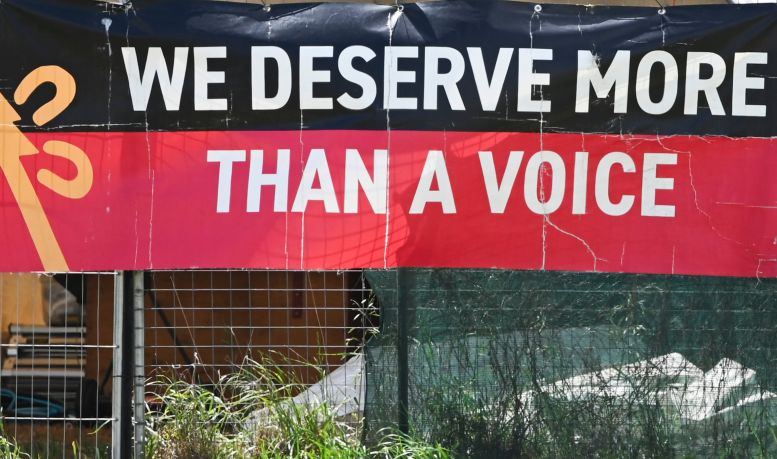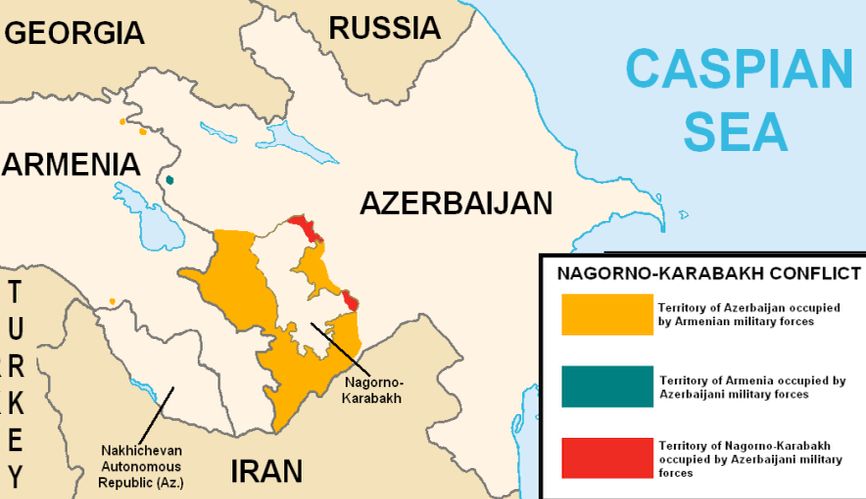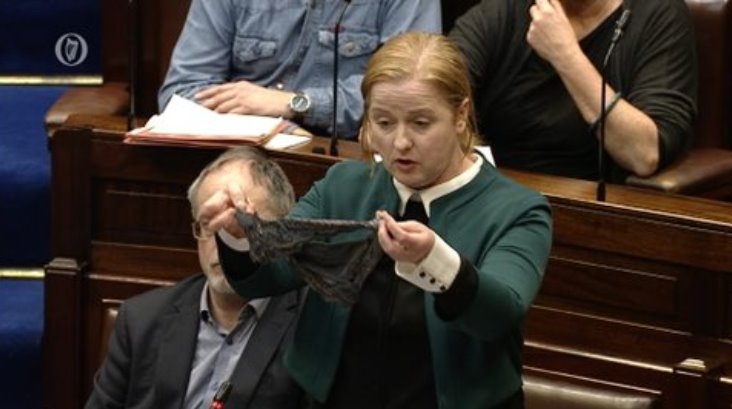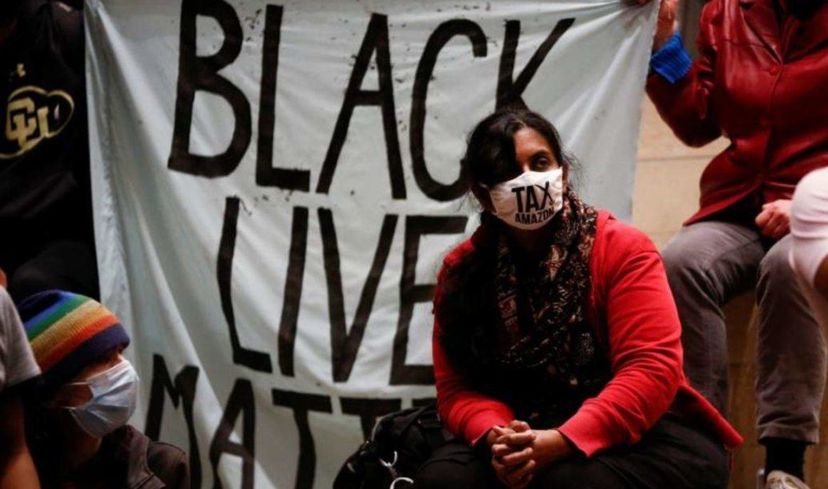Build a Powerful Movement for Indigenous Rights
More than 39% of the population have made clear that they want something to change. This is an excellent place to start rebuilding a powerful movement for Aboriginal rights. Activists should not take this as a sign to retreat or become fearful of other working-class people. Instead, it should be a signal to take action.
The Voice referendum resulted in a ‘No’ vote on October 14. The discussion of The Aboriginal Voice to Parliament was one marked by racism, and there will undoubtedly be more to come. There have been personal attacks against Indigenous activists. Football commentator Sam Newman called for people to boo “Welcomes to Country” — traditional ceremonies at public events to mark that they are held on land that before colonisation had traditionally been lived on, cared for and owned by Aboriginal and Torres Strait Islander people, and that there is an ongoing connection to that land.
Opposition Leader Peter Dutton disgustingly used the outcome of the vote to call for a Royal Commission into child sexual abuse in remote communities. This was an obvious dog-whistle — Dutton was referring back to the Northern Territory Intervention and the slanders of Aboriginal men by the Howard Government in 2007. The Intervention failed to turn up the abuse that it was looking for, and instead was used to roll over the rights of Indigenous communities and did incalculable harm.
The ‘Yes’ vote for the referendum on The Voice to Parliament was led by the Yes23 campaign. Yes23 was headed by a conservative assortment of CEOs, Liberal & Labor politicians, and right-wing pundits such as Noel Pearson and Marcia Langton.
They ran a deeply pessimistic campaign that failed to convince people, despite beginning the year with polls showing majority support for the Yes vote. At every step, Yes23 attempted to convince people that this would be the only possibility for change for generations, and they gave that as a primary reason for voting Yes.
But change has always come from the actions of ordinary people, organising in movements for our rights. It has never been handed down willingly by politicians. The dangers posed by racist right-wing politicians like Dutton are real, and we must mobilise to fight them. But Aboriginal people, and ordinary workers, are not helpless and hopeless the way some people would have us believe.
The results of the vote
While the Yes vote was very high in the cities, particularly in Melbourne, in rural areas ‘No’ dominated, and overall the No side reached 60% of the vote.
Remote Indigenous communities often returned particularly high Yes votes, comparable to the inner cities. The seat of Lingiari, which includes Alice Springs, returned a 56% No vote, but this vote was concentrated in Alice Springs itself, with remote communities in Lingiari returning a 73% Yes vote.
A large number of people — almost 3 million — did not vote. This is less than the number who abstained from voting in the 2017 marriage equality plebiscite, but much more than abstained from the 1999 republic referendum, and far more than have ever abstained from a federal election.
In March, polling tended to show majority support for the Yes vote — around 60%, exactly the reverse of what happened. Support in polls declined over the course of the year. In an ABC article by Laura Tingle, pollster Tony Mitchelmore threw doubt on the idea that the No vote was motivated by racism:
“Mitchelmore says the Voice rarely even rates a mention in focus groups and doesn’t even generate much discussion when it is brought up … The issue absorbing the focus groups is the cost of living. When polls were showing support for recognition and the referendum at around 60 per cent, Mitchelmore says, it was support based on sentiment — on the vague idea that, yes, Indigenous people had indeed had a bad time and that there was a significant body of goodwill to the idea of doing something to fix that. But it has not been possible to capture or crystallise that goodwill into the specific Voice proposal. “It’s that ‘I want to buy a new car but I am not sure about this one’ phenomenon,” he says.”
The background of the Voice
The Yes campaign was the culmination of a political effort that dates back to 2007, when John Howard, the architect of the Northern Territory Intervention, made a push for Aboriginal constitutional recognition. This evolved into the Recognise campaign.
This campaign has been opposed by many Aboriginal activists over the years, who have argued that constitutional recognition of Aboriginal people is directly at odds with the fight for Sovereignty and self-determination. Constitutional recognition has been described as a push for colonial assimilation.
Yes23 was funded by the same companies that benefit from the dispossession of Aboriginal people. It is heavily supported by capitalists invested in mining and agriculture, such as BHP, Rio Tinto, South32, Wesfarmers, Coles, Woolworths, and many more. These are some of the most powerful capitalist companies in Australia. It is no surprise that they would be in favour of a powerless advisory body and tokenistic constitutional recognition, but they would never support a proposal that could lead to real change.
Voice architect Noel Pearson, a staunch anti-welfare activist and friend to former prime minister John Howard, said the Voice would bring Australia to “a new understanding of who we are. A nation blessed with an Indigenous heritage spanning 60 millennia, a British democracy captured in its Constitution and a multicultural unity that is a beacon to the world.”
This is the same ‘British democracy’ that continually and systematically disenfranchises Indigenous people, and which is designed to leave power in the hands of capitalists, who depend on the exploitation of workers and the colonisation and pillaging of Indigenous land over the entire planet.
Many Aboriginal activists have rejected the idea that the Voice is a call from Aboriginal people. They point to the process of disenfranchisement that characterised the whole history of the push for constitutional recognition. From the Yulara convention that produced the Statement from the Heart, to the Recognise campaign itself, to the Regional Dialogues established by the Indigenous Voice Co-design Process, there were efforts to push radical Indigenous voices out of the discussion as much as possible. This was a window into how the Voice itself would have been constituted.
A demoralising campaign
Two of the most common arguments from the Yes campaign were that the opportunity for change would not come up again, and that anything of substance — beyond the powerless body of The Voice — was “too radical” for most people.
The official campaign promoted a scepticism of ordinary people, and this approach failed. Much of the last year has seen the Yes23 campaign lay the groundwork for a demoralising defeat, consistently saying that if the No vote passed, it would be a catastrophe that we cannot recover from.
Marcia Langton said, “It will be at least two generations before Australians are capable of putting their colonial hatreds behind them and acknowledging that we exist. … It’s very clear that reconciliation is dead.”
Much has been made of the idea that “false narratives” played a major part in the No vote, with references to the idea that The Voice would be “a third chamber of Parliament.” Ideas like this did circulate, as well as a number of deranged far-right conspiracy theories, but there hasn’t been much evidence yet that they had any significant impact.
The Labor Party was careful to constantly emphasise that The Voice would have no powers beyond providing advice to Parliament, and the referendum question itself made clear that it would be entirely under the control of Parliament.
Cause for optimism
We have every reason to reject the pessimistic views of the conservative Yes campaign. The initial goodwill toward the Voice proposal in March reflects a genuine solidarity toward Indigenous people by large numbers of working people.
The claim that people would never accept a more radical proposal is bizarre, considering the leading role that trade unionists have played in putting issues such as land rights onto the national agenda, forcing Labor politicians to adapt to the mood of ordinary people for Indigenous justice.
Working class people have an interest in fundamentally challenging the status quo, and a serious campaign to improve the situation for Indigenous and non-Indigenous workers would receive a genuine response, as it has many times over in the last two centuries. Scepticism of working-class people makes sense coming from the wealthy, conservative leaders of the Yes23 campaign. It is not an idea we need to put any faith in — this defeat belongs to the leadership of Yes23.
During the Yes campaign, union members were mobilised en masse to campaign and to vote for The Voice. This was driven by a union leadership that is hopelessly wedded to the Labor Party — they were campaigning for Anthony Albanese.
But despite the shortcomings of the Voice proposal itself, this mobilisation is a glimpse of what a genuine fighting union movement would be capable of. Imagine this level of engagement around a proposal for Indigenous self-determination that carried more weight and meaning for people.
A new movement
Regardless of any criticisms of The Voice, the Yes vote of 39% represents a genuine and heartfelt solidarity with Indigenous people from a significant portion of workers, particularly young workers.
The estimate of 60% support made in March also carries a lot of significance. This support was squandered by the leadership of the Yes23 campaign, who pandered to big business and failed to put forward a real proposal for change that could win real enthusiasm.
This provided an opening for the conservative No campaign to push a racist narrative, while actively sidelining and attempting to silence the anti-racist Sovereign No campaign — which was being promoted by a whole layer of Indigenous activists.
More than 39% of the population have made clear that they want something to change. This is an excellent place to start rebuilding a powerful movement for Aboriginal rights. Activists should not take this as a sign to retreat or become fearful of other working-class people. Instead, it should be a signal to take action.
Both Marcia Langton and Noel Pearson have said they will retire from politics following the defeat of The Voice. They are welcome to. Anthony Albanese acts as if The Voice was the most important vote for Aboriginal rights — but Aboriginal people have been using their voices for three decades calling on Labor governments to implement the 339 recommendations of the 1991 Royal Commission Into Aboriginal Deaths In Custody. Albanese refuses to listen. The Voice has been an excuse for him to do nothing on deaths in custody, Indigenous poverty and healthcare, land rights or self-determination.
The Voice was a project of a Labor government who have also done nothing about the cost-of-living crisis, who have allowed the Stage Three tax cuts for the rich while ending tax offsets for working-class people, who have refused to push public housing in a middle of a housing crisis, who are overseeing the historic collapse of the bulk-billing system that working people have benefitted from for 40 years, and who intend to spend billions of dollars of our money on submarines to appease the US war machine.
These are the kinds of people who control the narrative in Australian politics. These are the people behind The Voice, and behind its defeat. We need to build an independent working-class movement to put forward a different vision for society. This movement would need to be rooted in activism, based on trade unionists, community activists, and Indigenous Sovereignty activists. Only such a force can raise a narrative to counter the politics of the establishment.
Change comes from ordinary people taking action, not from politicians. The Aboriginal rights movement has never depended on the kinds of people behind Yes23 to win victories. We need to build a united movement to overthrow the system that fuels colonialism and genocide, endless war, and the impoverishment of working-class people.




